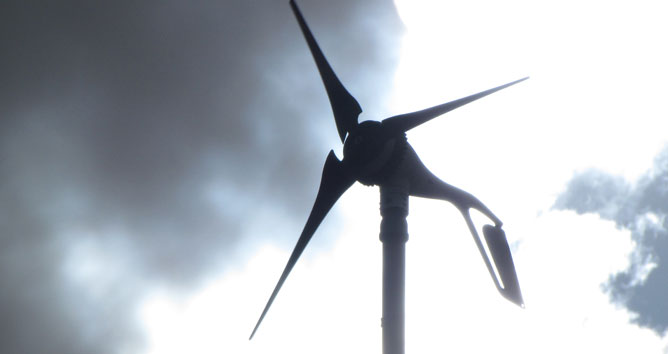Our electric system consists of five photovoltaic panels and a 400-watt wind generator, ten 6-volt, deep-cell golf cart batteries, a controller to keep the batteries from over-charging, and an inverter to change 12 volt direct current to 110 volt alternating current. There are various fuses and breakers to provide safety.
This would be considered a very basic energy system. We have enough energy to run our television and computer, lights and fan, toaster and microwave, and a curling iron for my wife. At this time we don’t have a washing machine. We could enlarge the entire electric system or use a generator on washdays. We have a propane refrigerator that we bought at a place that sells used RV parts. It costs $850 and it works great. We cook with propane. On rare occasions, we have had to moderate our use of the TV or the computer because our batteries were low. We could always add more solar panels or another wind generator and more batteries, but we would rather conserve energy than spend more money.
Here is a list of the components in our system:
•5 each Photovoltaic Panels
•3 each 75 watt panels $1,200
•2 each 100 watt panels 800
•1 each 400 Watt Wind Generator with a 47 foot tower 1,600
•10 each 6 Volt, Deep-Cell Golf Cart Batteries
•$65 each 650
•1 each Voltage Controller 100
•1 each Inverter, 1500 watt 1,000
•Miscellaneous Fuses, Meters, Breakers, etc. 250
TOTAL $5,600
I did not list brand names or get very specific in my parts list because I would rather not get into a detailed discussion of this particular system. There are many good options out there and these energy systems can be pretty complex. You need to find a reputable business that sells and services the components in your system. There are lots of here-today-gone-tomorrow, flaky people out there selling things that they do not understand. It is important to find a business that has been around for a while, with a reputation for service and honesty. I found a lady who actually lives off the grid. She uses the products she sells and has practical, working knowledge. Her service after the sale has been a blessing.
Living With Your Own Energy System
Making your own power does require some trial and error (hopefully, not too much error!), some study and a little bit of time. You learn to be more aware of your energy use. For instance, a sunny/windy day when your batteries are full is a great time to run the vacuum cleaner or use the microwave.
Maintaining the battery bank is the most time consuming chore related to energy system upkeep, but it is not difficult. The batteries I have are the type that most people use because of their reasonable price. They are deep-cell, lead acid batteries often used in golf carts. The batteries are contained in a vented box made from ¾” plywood. The box must be built sturdily because the batteries are very heavy. The vent, which is made of 2” PVC pipe, allows the escape of explosive hydrogen gas created when the batteries are charging or discharging. Because of the hydrogen gas it is a good idea not to work on the battery bank when it is being charged or discharged. Be very careful with metal tools so that sparks aren’t created.
Once a month I check each cell with a hydrometer, a tool costing about $10 that tests the specific gravity of the liquid inside the batteries. The individual cells should have about the same specific gravity. If not, the whole battery bank needs to be equalized. To equalize the battery bank there is a switch on my battery voltage controller that allows the voltage to rise above normal levels, up to about 15.5 volts. I leave the batteries in this high state of charge for 3 or 4 hours. Equalizing removes lead sulfate from the plates in the battery. It’s a good idea to equalize the batteries monthly. I learned a trick from the man who has been selling batteries to me for years. He suggested that I put one teaspoon of Epson salts in each cell. This also keeps sulfate from destroying the batteries.
After using the hydrometer I check the fluid level in each cell and add distilled water if necessary. While the cover is removed from the battery enclosure I check all the connections to see if they are loose or corroded, cleaning and tightening if necessary. Occasionally I check the connections on the solar panels. For more information about maintaining your energy system, there is an excellent article in issue 56 of Back Home magazine, on page 14.
I check the voltage of the battery bank daily by looking at my voltmeter. It is our goal not to go below 80% of full charge or 12.46 volts. The batteries last much longer if only the top 20% is used.
% of Charge Voltage Specific Gravity
100 12.70 1.265
90 12.58 1.249
80 12.46 1.233
70 12.36 1.218
60 12.28 1.204
50 12.20 1.190
40 12.12 1.176
30 12.04 1.162
20 11.98 1.148
10 11.94 1.134
0 11.90 1.120
These readings are correct at 75 degrees Fahrenheit. Back Home Magazine, Issue 56, p. 14.
That is about all there is to maintaining the power system. Once you get the hang of it, it requires only a few moments a day. The system is very reliable. In fact, we have electricity on days when our neighbors are sitting in the dark.
Many people say, “Gee, it must be great not to have utility bills!” The truth is, there is no free lunch … or power. While I do not receive a bill from a utility company, I must put some money aside to cover the expenses of maintaining the power system. My batteries tend to last from five to seven years. The inverter usually lasts many years, but not forever. If I have a problem, I have a problem. I cannot call the utility company and have them fix things. So, I save about $25 to $30 a month to cover maintenance expenses. Also, I spend about $25 to $30 a month on propane for the refrigerator, cooking, and hot water.
[For more information, leave us a message]
We make electricity on our homestead. We are completely “off the grid,” which means that we have no power coming to our property from outside. We do have a phone line, but that is all.
1. Avoid phantom loads (clocks, remote controls, etc.) These appliances are always drawing power, 24 hours a day!
2. Use another source of power (propane or kerosene) for refrigeration. Sundanzer DC refrigerators and freezers that operate on solar electricity are excellent, but expensive. You may want to consider a root cellar or other forms of preserving foods.
3. Use LED or florescent lighting.
4. Locate lights close to work areas. Placement will determine the effectiveness of the lighting.
5. Use smaller fans, placed close to your body or 12-volt ceiling fans, (120-volt ceiling fans don't work well with inverters.)
6. Use the smallest pump that will do the job.
7. Use direct current whenever possible.
8. Take good care of your batteries. Check them every day. Use only the top 20% of the batteries' power.
9. Adjust your panels at least twice a year to maximize power output. Panels should be perpendicular to the noonday sun.
10. Portable radios and clocks work well with AAA, AA, C and D batteries. Powering these appliances with small batteries helps keep your electric system simpler and smaller.
11. Compact florescent (CFLs) provide the most light per watt. (LEDs are a close second.) CFLs are most suitable to illuminate larger spaces.
12. Use stick-on push lights with LEDs. These are battery powered and easy to use. They cost about $4 each and are great where you need light for short periods of time—by the toilet, by the front door so you can see the lock, etc.
13. Consider when you use energy. If you use power in the morning, the batteries have time to recharge.
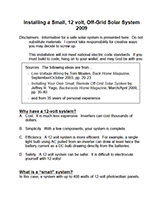
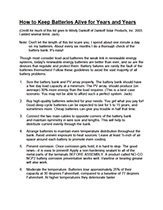
Dear Jack, Greetings to you! Let me tell you that [our solar project] went very smoothly, in large part because of your comprehensive analysis and information on the front end. There were absolutely no hitches, and after we prayed with the town and pulled the chain, the lights came on the first try! It was a good thing because we prayed for about twenty minutes and the group was growing more and more nervous! Let me tell you, the next morning we went down the mountain to a Tolupan village about four miles away, and the pastor up in San Garro, where we put the solar power, told us he was going to turn the lights on at 7:00 p.m. the next evening, and to be sure to look up toward them. The next night, when we looked up and saw what looked like star on top of the mountain –light where there had been none before, and the only one for miles--they knew that they had put Jesus' light in a "city on a hill" where everyone could see it. It was amazing to see, and the presence of God and His Holy Spirit was overwhelming.
–Reed, Nicaragua
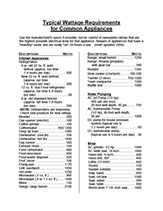
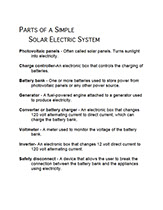
SIMPLE SOLAR ELECTRIC SYSTEM pdf
KEEP YOUR BATTERIES FOR YEARS pdf
BUILD A 12 VOLT ELECTRIC SYSTEM pdf
POWER REQUIREMENTS FOR APPLIANCES pdf





See Jack's presentation below at the 2014 Redeeming the Dirt Conference.
Read a missionary blog about his solar training experience with Jack here>
Meet Andy Eash, our missionary-in-training, who has designed and built a number of solar energy projects.


